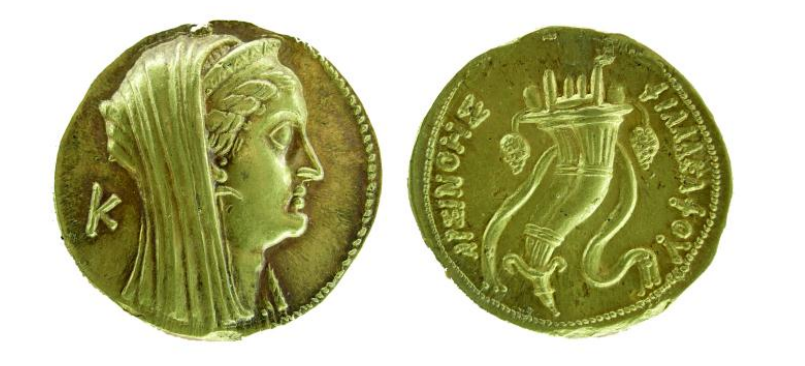Alexandria (Ptolemy VI and VIII), gold, mnaieia (Arsinoe/cornucopiae) (180-116 BCE)
From SILVER
180 BCE - 116 BCE Gold 341,412 kg
Description
| ObverseInscription or printing placed on the obverse.: | Head of Arsinoe II to right, wearing stephane, K left field |
| ReverseInscription or printing placed on the reverse.: | ΑΡΣΙΝΟΗE ΦIΛΑΔEΛΦOY (Greek).Cornucopiae filled with fruits and bound with fillet |
Mint and issuing power
| MintIdentifies the place of manufacture or issue of a numismatic object.: | Alexandria | Ancient regionAncient region.: | Egypt | Modern countryModern country: Egypt | AuthorityIdentifies the issuing power. The authority can be "pretended" when the name or the portrait of X is on the coin but he/she was not the issuing power. It can also be "uncertain" when there is no mention of X on the coin but he/she was the issuing power according to the historical sources: | Ptolemy VI Philometor (Ptolemaic king, 180-145 BC), Ptolemy VIII Physcon (169-164, 144-132/1 and 126-116 BC) |
Chronology
| FromIdentifies the initial date in a range assigned in a numismatic context. | 180 BCE | toIdentifies the final date in a range assigned in a numismatic context.. | 116 BCE | PeriodTime period of the numismatic object.: Hellenistic 323-30 BC |
Physical description
| MetalThe physical material (usually metal) from which an object is made.: | Gold |
Median weightMedian of the weights of numismatic objects (in grams). in grams | 27.60 | DenominationTerm indicating the value of a numismatic object. Examples: tetradrachm, chalkous, denarius.: | mnaieion |
StandardStandard.: | Ptolemaic |
References
| Die study referencePublication of the study: | Olivier 20121Olivier 2012, p. 168-174, n° 3360-3383 and 3403-3570 | ||
| Coin series referenceReference to coin series study: | |||
Obverse dies distribution
| FrequencyFrequency of specimen in distribution. ᵖ | Number of obversesNumber of obverse dies. ᵖ (o) | % (o) | Number of coinsNumber of coins. (n) | % (n) | Die nameName(s) of the die(s). |
| 1 | 18 | 34.62 | 18 | 9.38 | 1, 5, 6, 10, 11, 12, 13, 20, 23, 24, 30, 31, 38, 45, 47, 50, 55, 56 |
| 2 | 11 | 21.15 | 22 | 11.46 | 3, 4, 9, 28, 29, 36, 40, 43, 51, 52, 54 |
| 3 | 7 | 13.46 | 21 | 10.94 | 7, 19, 26, 34, 37, 41, 48 |
| 4 | 5 | 9.62 | 20 | 10.42 | 2, 8, 18, 35, 53 |
| 5 | 1 | 1.92 | 5 | 2.6 | 21 |
| 6 | 2 | 3.85 | 12 | 6.25 | 22, 27 |
| 7 | 2 | 3.85 | 14 | 7.29 | 33, 49 |
| 8 | 1 | 1.92 | 8 | 4.17 | 32 |
| 9 | 1 | 1.92 | 9 | 4.69 | 32 |
| 11 | 1 | 1.92 | 11 | 5.73 | 39 |
| 12 | 1 | 1.92 | 12 | 6.25 | 46 |
| 16 | 1 | 1.92 | 16 | 8.33 | 42 |
| 24 | 1 | 1.92 | 24 | 12.5 | 25 |
| Total | 52 of 52 | 99.99 | 192 of 192 | 100.01 |
Reverse dies distribution
no distribution is available
Quantification
| Number of obversesNumber of obverse dies. ᵖ (o) | 52 | Number of singletons (o1)The number of singleton coins. ᵖ | 18 |
| Number of reverse diesNumber of reverse dies. (r) | 148 | Number of coinsNumber of coins. (n) | 192 |
| Coins per obverse dieNumber of coins per obverse die. (n/o) | 3.69 | Coins per reverse dieNumber of coins per reverse die. (n/r) | 1.3 |
| Reverse per obverse ratioRatio of obverse dies divided by reverse dies. (r/o) | 2.85 | Percentage of singletons (o1)number of coins (n) divided by the number of singletons (o1) ᵖ | 34.62 % |
| Original number of dies (O) (Carter 1983 formula)The estimation of the number of coins according to Carter 1983 ᵖ | 61.85 | Coins struck if 20,000 as average productivity per dieCoins made if the average productivity for obverses (according to Carter) is 20,000. ᵖ | 1,237,000 |
| Original number of dies (O) (Esty 2011 formula)The estimation of the number of coins according to the singleton formula in Esty 2011 ᵖ (O) | 71.31 | Survival rate if 20,000 as average productivity per dieSurvival rate if average productivity is 20,000. ᵖ | 0.00016 |
| Coverage (o = % of O) (Esty 1984 formula)Esty 1984 - coverage (% of O) ᵖ (o = % of O) | 90.63% | Die productivity if survival rate 1/2,000Average productivity if survival rate is 1/2,000. ᵖ | 6,208.57 |
| Weight of silver (in kg) if 20,000 coins per die (O = Carter formula)Carter 1983 * Median weight * 20000 (*10 if gold or electrum) ᵖ | 341,412 kg <br /> 341,412 kg | Die productivity if survival rate 1/5,000Average productivity if survival rate is 1/5,000. ᵖ | 15,521.42 |
Remarks
Most likely one single workstation Likely military
References
- ^ Olivier, Julien (2012), Archè et Chrèmata en Egypte au IIe siècle avant J.-C. (204-81 av. J.-C.). Etude de numismatique et d'histoire, [Unpublished doctoral dissertation], Orléans University, 2012.
